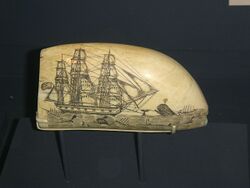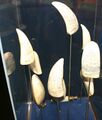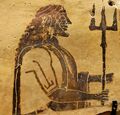Scrimshaw (nonfiction)
Scrimshaw is the name given to scrollwork, engravings, and carvings done in bone or ivory.
Typically it refers to the handiwork created by whalers made from the byproducts of harvesting marine mammals. It is most commonly made out of the bones and teeth of sperm whales, the baleen of other whales, and the tusks of walruses.
It takes the form of elaborate engravings in the form of pictures and lettering on the surface of the bone or tooth, with the engraving highlighted using a pigment, or, less often, small sculptures made from the same material. The latter properly fall into the categories of ivory carving, for all carved teeth and tusks, or bone carving.
The making of scrimshaw began on whaling ships between 1745 and 1759 on the Pacific Ocean, and survived until the ban on commercial whaling.
The practice survives as a hobby and as a trade for commercial artisans.
A maker of scrimshaw is known as a scrimshander.
The word first appeared in print in the early 19th century; the etymology is uncertain.
In the News
Scrimshaw binge residue, confined to knife-proof vitrine to prevent re-infection.
Captain Cinnamon Jack plans daring raid on priceless scrimshaw collection.
Poseidon admires scrimshaw. (550–525 BC). Inscription (not shown) reads: "Excellent cross-hatching. P."
Fiction cross-reference
Nonfiction cross-reference
External links:
- Scrimshaw @ Wikipedia




